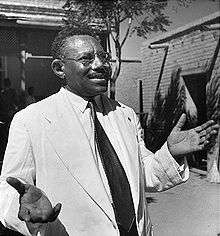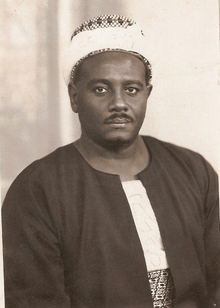Sudanese parliamentary election, 1968
| | |||||||||||||||||||||||||||||||||||||||||||||||
| |||||||||||||||||||||||||||||||||||||||||||||||
| |||||||||||||||||||||||||||||||||||||||||||||||
| |||||||||||||||||||||||||||||||||||||||||||||||
 |
| This article is part of a series on the politics and government of Sudan |
| Constitution |
|
Judiciary
|
|
|
Related topics
|
Parliamentary elections were held in Sudan between 12 April and 2 May 1968. The election followed the resignation of a third of the members of the Assembly elected in 1965.[1] The result was a victory for the new Democratic Unionist Party, formed by a merger of the National Unionist Party and the People's Democratic Party in December 1967 and led by President Ismail al-Azhari, which won 101 of the 218 seats. Voter turnout was 61.0%.[2]
In contrast, since the last election the Umma Party had fractured, with competing wings being led by Sadiq al-Mahdi and Imam al-Hadi al-Mahdi. Whilst Sadiq's Umma party emerged as the stronger of the two wings, Sadiq actually lost his own seat in the election to a rival from the Imam wing.[3] In total the various Umma party affiliates won some 827,289 votes, or 45.46% of the vote, compared to the 40.8% won by the DUP. The Umma affiliates won only 72 seats, in contrast to the 90 seats won at the previous election.
Results
| Party | Votes | % | Seats | +/– | |
|---|---|---|---|---|---|
| Democratic Unionist Party | 742,226 | 40.8 | 101 | New | |
| Umma Party-Sadiq | 384,986 | 21.2 | 36 | New | |
| Umma Party-Imam | 329,952 | 18.1 | 30 | New | |
| Independents | 70,047 | 3.9 | 9 | ||
| Sudan African National Union | 60,493 | 3.3 | 15 | ||
| Islamic Charter Front | 44,552 | 2.5 | 3 | ||
| Umma Party | 43,288 | 2.4 | 6 | ||
| Southern Front | 39,822 | 2.2 | 10 | New | |
| Socialist Front | 21,814 | 1.2 | 0 | New | |
| Socialists | 19.690 | 1.1 | 0 | New | |
| Beja Congress | 15,382 | 0.9 | 3 | ||
| National Unionist Party | 10,159 | 0.6 | 0 | New | |
| No political affiliation[4] | 8,264 | 0.5 | 1 | New | |
| Tenants' Union | 6,661 | 0.4 | 0 | New | |
| Workers' Forces | 5,204 | 0.39 | 1 | New | |
| Nuba Mountains Union | 3,171 | 0.2 | 2 | New | |
| Nile Party | 2,704 | 0.2 | 1 | New | |
| Liberal | 1,844 | 0.1 | 0 | New | |
| Islamic | 1,772 | 0.1 | 0 | New | |
| Western Sudan Union | 1,695 | 0.1 | 0 | New | |
| Sudanese Communist Party[4] | 1,652 | 0.1 | 0 | New | |
| Democratic South | 1,535 | 0.1 | 0 | New | |
| Unity | 1,478 | 0.1 | 0 | New | |
| Workers' Federation | 668 | 0.0 | 0 | New | |
| Peace | 387 | 0.0 | 0 | New | |
| Socialist Democrats | 220 | 0.0 | 0 | New | |
| National Unionist Party-Sadiq | 63 | 0.0 | 0 | New | |
| Congress of New Forces | 33 | 0.0 | 0 | New | |
| Invalid/blank votes | 43,139 | – | – | – | |
| Total | 1,862,911 | 100 | 218 | +11 | |
| Registered voters/turnout | 3,051,118 | 61.0 | – | – | |
| Source: Nohlen et al. | |||||
References
- ↑ Sudan Inter-Parliamentary Union
- ↑ Nohlen, D, Krennerich, M & Thibaut, B (1999) Elections in Africa: A data handbook, p855 ISBN 0-19-829645-2
- ↑ Dictionary Of Modern Arab History. Routledge. p. 259.
- 1 2 The Sudanese Communist Party had been banned in 1966, and couldn't formally participate in the election. Two candidates were listed in the official election results as 'Communists'. However, the party general secretary Abdel Khaliq Mahjub was elected from Omdurman South but listed by the Election Commission as having 'no political affiliation'. see ARR: Arab Report and Record. Economic Features, Limited. 1968. p. 144., Timothy Niblock (25 November 1987). Class and Power in Sudan: The Dynamics of Sudanese Politics, 1898–1985. Palgrave Macmillan UK. p. 230. ISBN 978-1-349-08836-2., Peter K. Bechtold (1976). Politics in the Sudan: Parliamentary and Military Rule in an Emerging African Nation. Greenwood Publishing Group, Incorporated. p. 249. ISBN 978-0-275-22730-2., Robert S. Kramer; Richard Andrew Lobban; Carolyn Fluehr-Lobban (2013). Historical Dictionary of the Sudan. Rowman & Littlefield. p. 39. ISBN 978-0-8108-6180-0.


